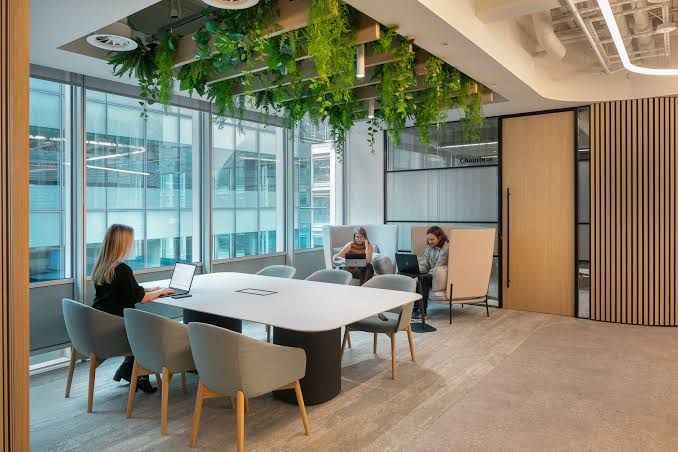Today, offices are in search of different ways to achieve peak productivity from their employees. Employee well-being is now a concern more than ever. In such scenarios, maintaining a vibrant company culture has become a necessity. From phenomenal technological support to ergonomic furniture and elaborate atmospheres for team-building initiatives, offices are investing their time, money and efforts into boosting employee morale.
Yet, one of the most underrated and overlooked aspects of a vibrant employee culture is natural light. The presence and quality of natural light within a workspace creates a positive atmosphere, emphasised by top office interior designers. Employees feel motivated at their desks, leading to increased performance and contributions. Many offices, in fact, appreciate the importance of natural light.
Let’s see how natural light plays a key role in boosting the vibrancy and productivity of workplaces.
Is There Any Science Behind the Sunshine?
The contribution of the natural light on the role of natural light to employee morale is not just anecdotal. It also has robust support from the scientific community.
Vitamin D Source
Firstly, natural light is the direct source of vitamin D. While direct exposure to sunlight in office premises may not be feasible, sufficient levels do contribute to vitamin D synthesis. It is a vital nutrient to maintain strong bone health. It bolsters immune functioning to significantly regulate your mood.
Regulates Circadian Rhythm
Secondly, natural light is found to be a useful tool to regulate the circadian rhythm. If the interiors are well-planned to allow sufficient natural light inside, it helps maintain a strict check on melanin levels. It is a hormone that induces sleep. The hormone contributes to promoting mind alertness, sharpening cognitive functioning, and sustained energy. Conversely, a lack of this light, especially during working hours, might impact this circadian rhythm. Poor sleep quality and daytime fatigue are common symptoms. As a result, offices might see an increase in absenteeism across all departments.
Reduces Eye Strain
The presence of natural sunlight enhances employees’ visual comfort significantly. With this increase, it reduces eye strain. Artificial light, particularly fluorescent lights are key culprit for distracting flicker, glare, and dynamic variations. It significantly reduces dry eyes, headaches, and general visual fatigue.
Cherishing Mood
Finally, natural light is a great tool to elevate your mood and overall well-being. The advantage here is that it maintains a connection with the outdoors. Every simple nature act offers a sense of calm and tranquillity, and so is the role of natural light in employee morale.
Practical Strategies for Harnessing Natural Light
The role of natural light is thus pivotal in boosting employee morale. However, effective strategies are necessary to maximise its benefits.
Maximise Existing Window Space
It is not a surprising fact to see most of the offices having windows blocked or obstructed by tall furniture. Regularly auditing workspaces is essential to ensure that natural light has sufficient space to enter. You can consider using window coverings to easily adjust the glare.
Strategic Desk Placement
Strategise the locations of workstations and desks closer to the office windows. The open-plan offices, with layouts that ensure the maximum number of employees have access to natural light, are ideal. Periodically rotating desks can also be helpful in this case.
Open-Plan Design & Glazed Partitions
Modern office designs favour open-plan layouts with partitions in place of solid walls for the internal offices and meeting rooms. It allows natural light to enter, even the deepest core, benefiting most employees.
Light-Coloured Interiors
Light reflective colours are ideal for walls, ceilings, and furniture. Lighter shades bounce the natural light entering the room around the space. It makes the room brighter and more inviting.
Maintain Clean Windows
It is one of the most underrated or overlooked factors. Dirty windows significantly lower the natural light entering the office space. Regularly scheduling cleaning, especially in urban spaces, could make a big difference.
Implement Light Sensors & Smart Lighting Systems
In areas where natural light fluctuates due to insufficiency, smart lighting systems are well-integrated to adjust the levels of artificial light.
Incorporate Biophilic Design Elements
Beyond the concept of light, incorporating natural materials such as plants and other related elements mimics natural patterns to enhance the natural connection.
The Tangible Benefits for Offices
Investing in natural light isn’t just a feel-good initiative; it translates into tangible business benefits:
- Increased Productivity: Alert, well-rested employees with reduced eye strain are more focused and efficient.
- Reduced Absenteeism: Better sleep, reduced stress, and improved immune function can lead to fewer sick days.
- Enhanced Employee Retention: A workspace that prioritises well-being is a powerful draw for top talent and fosters loyalty.
- Improved Mental Health: Mitigating SAD symptoms and general low mood contributes to a happier, more resilient workforce.
- Lower Energy Costs: Reduced reliance on artificial lighting during daylight hours can lead to significant savings on electricity bills.
Read More: Interior Design Trends in Wholesale Drapes and Curtains
Lighting the Way to a Happier, More Productive Workplace
Offices strive to cultivate a high-performing, healthy, and happy workforce. Thus, understanding and actively prioritising the role of natural light in employee morale is not merely beneficial; it is essential. Thoughtfully integrating natural light sources into workspace designs, offices can illuminate their spaces better. It also boosts the spirit and performance of their most valuable employees.
Connect with the best office interior designers in Kolkata and plan your new office design.



